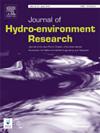An iterative hydraulic design methodology based on numerical modeling for piano key weirs
Abstract
Piano Key Weir (PKW) is a special type of overflow weir which provides an improved discharge capacity with its increased crest length. Increased discharge capacity makes this weir an attractive alternative in the rehabilitation of existing spillways. After the introduction of this new weir type, many experimental and numerical studies are conducted to understand the effect of the numerous geometrical parameters on the discharge capacity. However, empirical discharge formulas suggested by different researchers are not conforming to a unique expression mostly due to dependence on the experimental conditions from which they are derived. A numerical approach is used in the present study to investigate the dependence of discharge capacity of a PKW unit on several geometric parameters. Numerical models are developed and three-dimensional velocity fields are computed using FLOW-3D® software. Discharge efficiency of a PKW over an equivalent linear sharp-crested weir is evaluated within the practical range of parameters from 145 numerical solutions for 29 different PKW models. Numerically obtained data is used to form dimensionless expressions for the weir height and length as function of discharge efficiency which are proposed to facilitate an iterative numerical solution to meet the design requirements of a given project. This approach allows cost optimization while dimensioning the PKW for the required hydraulic capacity. The design procedure based on iterative numerical solutions is described and exemplified.

 求助内容:
求助内容: 应助结果提醒方式:
应助结果提醒方式:


